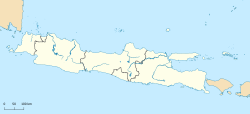
Back Kabupatén Ngawi BAN Kabupatèn Ngawi BEW Kabupaten Ngawi CEB Ngawi (Regierungsbezirk) German Kabupaten de Ngawi French Kabupaten Ngawi ID Reggenza di Ngawi Italian Kabupatèn Ngawi JV Kabupaten Ngawi KGE Kabhupatèn Ngawi MAD
Ngawi Regency
Kabupaten Ngawi | |
|---|---|
| Other transcription(s) | |
| • Javanese | ꦏꦧꦸꦥꦠꦺꦤ꧀ꦔꦮꦶ |
From top, left to right: Pondok Reservoir, Jamus Tea Plantation in Sine, Soerjo monument statue in Widodaren town | |
| Nickname(s): Ngawi Ramah • Benteng • Bambu Friendly Ngawi • Fortress • Bamboo | |
| Motto(s): Negeri Ngawi Ramah Friendly Ngawi Country | |
 Location within Ngawi Regency | |
| Coordinates: 7°24′11″S 111°26′40.7″E / 7.40306°S 111.444639°E | |
| Country | |
| Province | East Java |
| Anniversary | 7 July 1358 |
| Capital | Ngawi |
| Government | |
| • Body | Ngawi Regencies Government |
| • Regent | Ony Anwar Harsono |
| • Vice Regent | Dwi Rianto Jatmiko |
| • Regional Secretary | Mokh. Sodiq Triwidiyanto |
| • Speaker of the regional parliament | Heru Kusnindar |
| Area | |
• Total | 1,394.74 km2 (538.51 sq mi) |
| Highest elevation | 3,156 m (10,354 ft) |
| Lowest elevation | 47 m (154 ft) |
| Population (mid 2023 estimate)[1] | |
• Total | 904,094 |
| • Rank | 76th in Indonesia |
| • Density | 650/km2 (1,700/sq mi) |
| Demographics | |
| • Ethnic groups | Javanese people Osing Madura Sundanese Batak Chinese Others. |
| • Religion |
|
| • Languages |
|
| Time zone | UTC+07:00 (IWST) |
| Postal code | 63211 – 63285 |
| Area code | (+62) 351 |
| ISO 3166 code | ID-JI |
| Vehicle registration | AE J**/K**/L*/M* |
| HDI | |
| Website | ngawikab.go.id |
Ngawi Regency (Javanese: ꦏꦧꦸꦥꦠꦺꦤ꧀ꦔꦮꦶ) is an inland regency (kabupaten) of Indonesia, on the island of Java. Ngawi is well known around the world for its Pithecanthropus erectus which was found by Eugene Dubois, a Dutchman. Ngawi is located in East Java Province but adjoins Central Java province. Its capital is Ngawi. Ngawi is also the main gate to enter East Java province since there are intersections that connect Surabaya–Bojonegoro–Ngawi–Solo–Jogja–Bandung–Jakarta. The Regency covers an area of 1,394.74 km2 (538.51 sq mi), and had a population of 817,765 at the 2010 census[2] and 870,057 at the 2020 census;[3] the official estimate as of mid-2023 was 904,094 (comprising 449,052 males and 455,042 females).[1]
Ngawi (town), has the largest central park ("alun-alun") in Indonesia. This large area includes a West Park and an East Park, separated by Merdeka Street. The West Park consists of a football court, a volleyball court, and a ceremonial podium near the main mosque. The East Park consists of a playground area, two tennis courts, a basketball hall, a parking area, a futsal court, a skating place, and a culinary area said to be "the most favorite place visited by Ngawinese". The municipal hall (called Alun-Alun Merdeka) is located in the central part of Ngawi town.
Van Den Bosch Fortress is a central historic site of the Ngawi Regency. It is located at the confluence of the two biggest rivers in East Java: the Solo River and the Madiun River.





